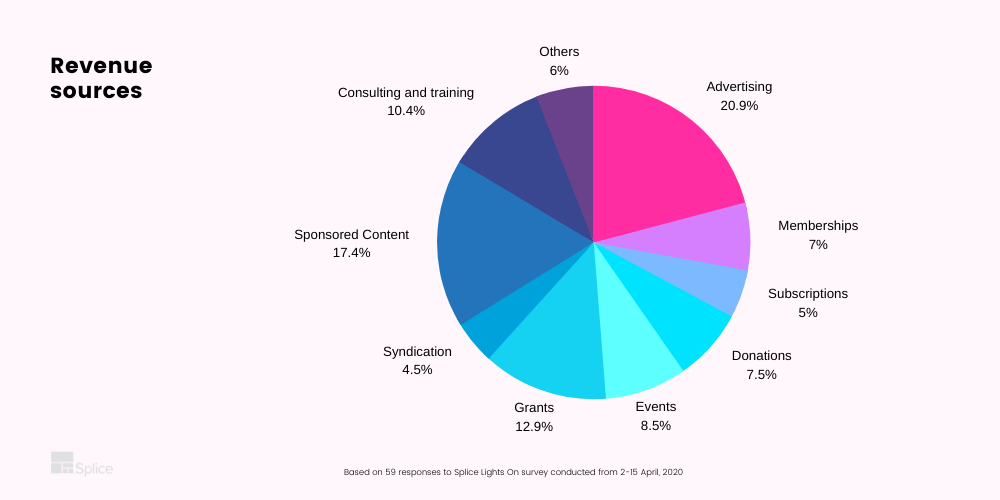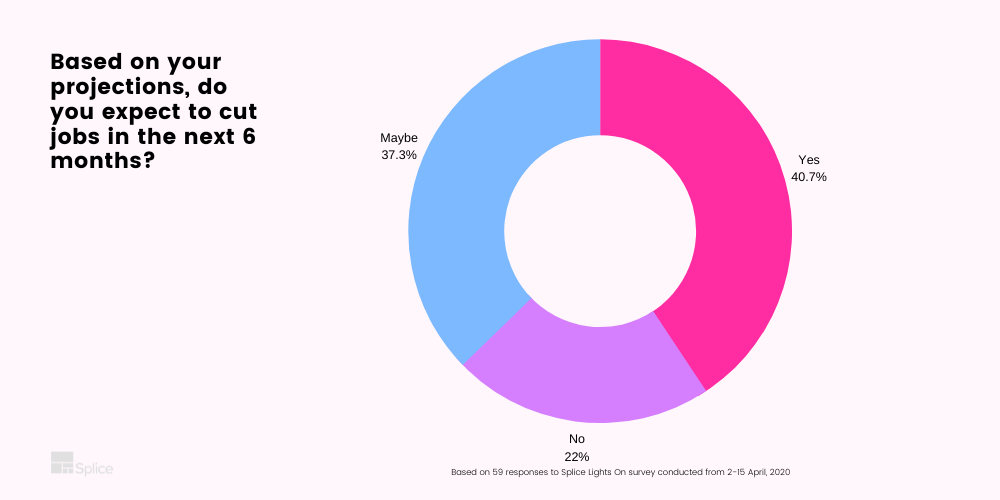The Splice Lights On survey shows that over 40% of media orgs expect to start cutting jobs in the next 12 months.
Update: Splice worked with Facebook to distribute $5,000 micro-grants in support of small- to mid-sized news orgs and their freelancers in Asia financially affected by Covid-19. Details here.
There’s another curve to be flattened. But that needs to start now.
Over the past two weeks, we ran Splice Lights On, a survey of the financial conditions at media companies around the world. With the help of our media partners, we put the word out on social media inviting media owners and newsroom leaders to fill in the survey. We had 59 responses.
The survey provides a dire warning of what’s to come:
Respondents say their businesses rely heavily on advertising and sponsored content, which have been severely affected by Covid-19
A weak revenue position affects their ability to address their main fixed monthly costs: full-time employees, part-time staff, office space
As a result, most respondents expect to have to cut jobs in the next 6 months unless they get help on their operational cashflow and payrolls
The details
Covid’s impact on media companies has all of us worried. Advertising has dried up, while newsrooms are doubling down on covering the pandemic, at times putting journalists at physical and mental health risk.
The global community of media — entrepreneurs, journalists, investors, tech — needs an urgent response to this. And that’s why we ran this survey.
How much financial runway is left in newsrooms? How many media jobs could be lost? Our goal was to get a better picture of the financial situation at media companies across the globe, so that we can all make better decisions on where to focus our efforts.
This survey ran from 2-15 April, 2020 and was distributed on social media. As this was an open survey, we were not able to determine the authenticity of responses. The survey is also written in English, and is therefore limited in its reach.
So far, we’ve had 59 responses from 30 countries: Singapore, Philippines, Hong Kong, Indonesia (with the most number of responses), Brazil, Australia, Myanmar, Nicaragua, Nepal, Cambodia, United States of America, Serbia, Ukraine, Vietnam, Lebanon, Jordan, Bangladesh, North Macedonia (formerly Macedonia), Malaysia, Portugal, Thailand, Mongolia, Sri Lanka, Japan, El Salvador, Kenya, Ecuador, New Zealand, Brunei, and Argentina.
Findings
Most of these newsrooms are small, with staff of under 30. We had a small number reporting staff sizes of above 50.
They are diverse in reach and audience, from community radio in Bangladesh and news in metro Sao Paulo to reporting in the Kibera slum of Nairobi and a community for Cambodian students and young professionals.
Most respondents say they’ve been negatively affected by the pandemic.
In our Splice Lights On survey, barely a third of respondents said they expect to be able to run their businesses with the current cost structure. Most expect to cut jobs.
A majority of respondents said their average monthly operating costs were between $10,000 and $30,000.
Revenue sources were diverse, including advertising, memberships, subscriptions, donations, events, grants, consulting, and syndication.
The hardest hit revenue sources were advertising and sponsored content. Events took the third-biggest impact. Memberships and subscriptions were fourth and fifth respectively.
Full-time staff was the number one cost. Part-time staff was second while office space was third.
This is where it gets worrying. Barely a third of respondents said they expect to be able to run their businesses with the current cost structure. A fifth see a 3-6 month runway.
Over 40% say they expect to cut jobs in the next 6 months while more than a third say they may have to trim jobs.
One third of our respondents say they need help with their operational cash flow, and just over a fourth say they need help with payroll.
Trimming costs
Many have already taken steps to cut spending. Measures include
Working from home
Moving workshops online
Focusing on different formats such as research and investigations
Suspending print editions and solely publishing online
Suspending regional reporting
Suspending planned salary increases
Cutting full-time staff
Stopping advertising
Cancelled plans to hire consultants
Cutting back on freelancers
Drawing no salary
Cutting software subscriptions where possible
Shutting the office
Terminating wire subscriptions











